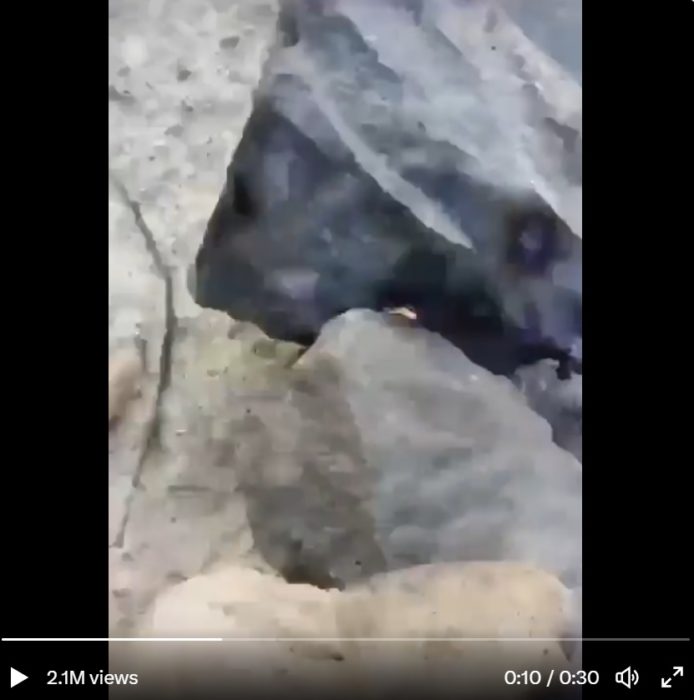Jan 27 2023
Electricity from Rocks?
 There are several viral videos spreading claiming to demonstrate a large electric charge stored in certain kinds of rocks in Africa. The most popular is this one which alleges to show electrically charged rocks from the Democratic Republic of Congo (DRC). When touched together the rocks give off large sparks which leave burn marks on the stones. The comments are mostly amusing and sad, reflecting the cultural turmoil of the region. A few figured out what is happening here.
There are several viral videos spreading claiming to demonstrate a large electric charge stored in certain kinds of rocks in Africa. The most popular is this one which alleges to show electrically charged rocks from the Democratic Republic of Congo (DRC). When touched together the rocks give off large sparks which leave burn marks on the stones. The comments are mostly amusing and sad, reflecting the cultural turmoil of the region. A few figured out what is happening here.
We can start by evaluating the plausibility of the claim. The sparking is not a single event, as if there were static electricity in the rocks that discharged. They continue to discharge without diminishing. It is implausible that a natural ore (i.e. not a battery) would contain so much electricity. Also, where would the electricity come from? Some commenters through out the piezoelectric effect, the transformation of mechanical stress to current, but this only produces a tiny amount of electricity. Even if there were some small amount of static electricity in the material, this would not be a source of power, as some seem to believe.
What about the video itself? There are countless deceptive and fake videos on social media, so it’s good to have some basic idea how to recognize deception. I recommend Captain Disillusion’s Youtube channel – he is a digital effects expert who examines dubious videos and reveals their deception. On this video there are some immediately suspicious features. First, the video is very close-up. We are seeing just the rocks with little space around them. Close-cropping like this is a standard technique for hiding things out of view of the lens. An honest video documenting a phenomenon would show the environment and the setup, and show multiple angles and perspectives. It may zoom in at some point, but if all you see if a super close-up, be suspicious.
The most highly suspicious feature of the video, however, is the brief glance you get at the brick on the ground right behind one of the rocks. What’s it doing there? It seems oddly out-of-place, or at least completely random – unless it is there to hide the wire that is connected to the rock on the ground. The other rocks, the one held by the gloved hand (for insulation) we never see completely, so it also can easily be hiding a wire. The simplest explanation is that one rock is connected to a positive electrode of a battery while the other is connected to the negative electrode. Anyone who has touched the cables connected to a car battery has seen sparks of this magnitude. The rocks themselves only need to have some iron ore or other conducting mineral in them.
Another video, showing a completely different kind of rock apparently powering an LED lightbulb, is being spread alongside the first one. Again, the demonstration is likely a deception. Even if there were a small amount of electrical charge in the rock, just holding it would likely discharge it, and just touching it with wires would not produce a steady flow of current. LED bulbs use very little electricity, so it is easy to hide a small watch battery in this setup. Perhaps that suspicious flat circle on the rock.
These deceptive techniques are also common in many “free energy” videos. The demonstration often includes very small amounts of electricity, which can easily come from a variety of sources other than the claimed free energy. Either that or the setup suspiciously allows for a deliberately hidden source of electricity.
Again with this video the discussion turns to the exploitation of African natural resourced by the West. This is a complex topic I don’t mean to get into here. Suffice to say, there has absolutely been exploitation, but also the DRC has significant governance problems. It has an abundance of mineral resources, including lithium and cobalt critical for the green revolution, and coltan which is critical for many electronic devices. Extraction of these minerals has had significant negative effects on the local ecosystem, and the profit from these minerals generally does not benefit local populations. This situation creates a powerful narrative that the DRC has an abundance of minerals critical for modern technology, but is being taken without truly benefitting the people. These videos of “magic” rocks (with many references to vibranium) fits well into this narrative.
The problems faced by the DRC are real, but these electrical rock videos are fake.






